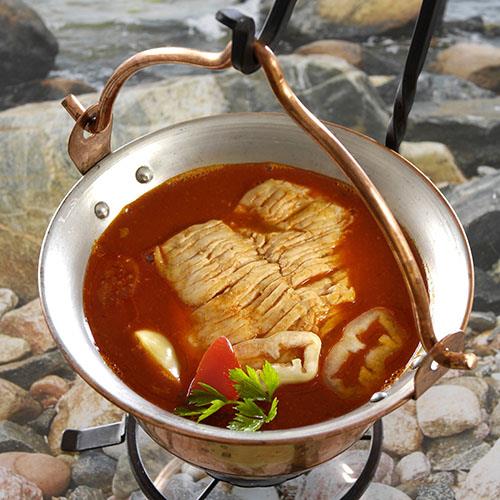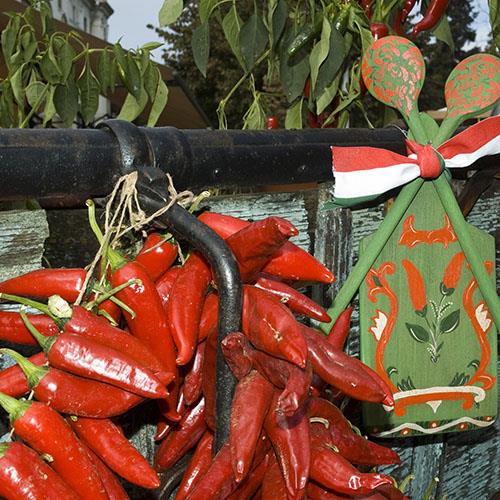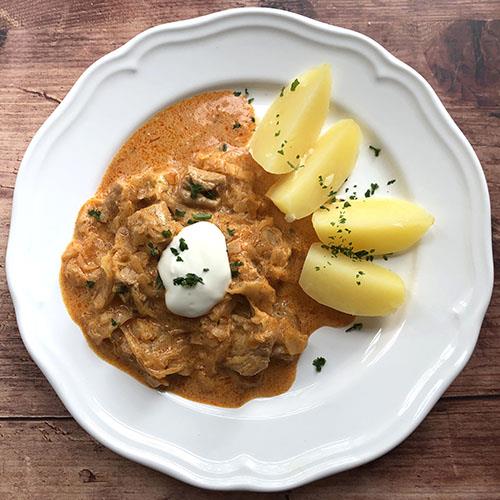A SHORT HISTORY OF HUNGARIAN CUISINE


The Magyars were the last major ethnic group to settle in Continental Europe, arriving at the end of the ninth century CE. They brought with them certain culinary traditions they picked up while living in the Ural Mountains, such as the reliance of chicken, pork, and lamb in main dishes, and the tradition of cooking soups and stews in a cauldron (called bogrács in Hungarian). (First picture: The fish chowder halászlé cooked in a traditional Magyar cauldron.) Other traditions were picked up by learning from their neighbors and rulers: like the Czechs and Slovaks, Hungarians enjoy lots of dairy in their diet; the national spice paprika was introduced to Hungary by the Ottomans by way of Mexico; and the usage of such components as kefir and poppy seeds come from Hungary's Slavic neighbors.
Popular dishes that can be enjoyed nationwide include gulyás (goulash, the national dish, a beef and vegetable stew flavored with sweet paprika); lángos (second picture), a fried bread which can be eaten alone or served with sour cream and cheese on top; and the aforementioned halászlé, one of the oldest dishes to originate from Hungary, a "fisherman's stew" which has multiple regional variations.
Must-Savor Specialties: Paprika, gulyás, lángos, halászlé
A SAMPLING OF FOOD CITIES AND REGIONS IN HUNGARY

Budapest
Budapest, which has long been a European leader in arts and culture, finally boasted a food scene to match after the fall of Communism. Especially as the country joined the European Union in 2004, more and more foodstuffs became available than the previous generation ever dreamed of, marking a food renaissance not just for the dining scene in Budapest but for Hungarian cuisine in general. The food scene in Budapest reached its zenith in the period between 2013-18, when hundreds of acclaimed restaurants opened their doors, serving a variety of international cuisines in addition to traditional Hungarian fare. Some of the most acclaimed recent arrivals to the food scene are Stand25 Bisztró (Attila út 10), opened by the world-renowned former executive chef of the Michelin-starred Onyx (Vörösmarty tér 7-8); the Transylvanian-inspired and Michelin-starred Babel (Piarista köz 2); and Gettó Gulyás (Wesselényi utca), which gives a modern spin on traditional Hungarian classics, located in the Jewish Quarter.
Budapest is the place you will find the largest variety of restaurants serving gulyás. The aforementioned Stand25 Bisztró is considered one of the top places in town to try this popular dish. Csontvelo is a delicacy consisting of the marrow of beef bones, which resemble the consistency of crème brûlée and can be spread on bread, toast, or enjoyed on its own or in a soup just as húsleves, a beef consommé which includes bone marrow. Kéhli Vendéglo (Mókus utca 22) sells all of these dishes as appetizers, as well as bone marrow as an entrée.
Budapest's long Jewish history has also impacted its culinary scene, and Jewish favorites such as sólet (bean stew with paprika, duck, boiled eggs, and onions) are served alongside popular Magyar dishes such as lecsó (Hungarian-style ratatouille with an emphasis on hot paprika and sweet yellow peppers) at esteemed restaurants such as Rosenstein (Mosonyi utca 3). Gettó Gulyás, mentioned previously as also in the Jewish Quarter, is considered the best place in town to try the meat-and-paprika stew pörkölt, served with potatoes and either bread or dumplings (galuska).
Must-Savor Specialties: Gulyás, csontvelo, húsleves, sólet, lecsó, pörkölt with galuska

Eger
The northern Hungarian town of Eger is located smack in the middle of perhaps the most popular wine region in Hungary, and is well-known for the Bull's Blood of Eger (Egri Bikavér), a delicious red wine. As a result, most foods that Eger is well-known for must pair well with this signature wine. It is well-known as a food city, with a high number of restaurants, cafés and bistros relative to its size (the 19th-largest city in Hungary). The restaurant 1552 (inside Eger Castle) serves delicious Hungarian and Turkish dishes, in honor of the 1552 Siege of Eger by the Ottomans. The uniquely Hungarian dish fozelék (in between a soup and a stew, it consists of boiled simmered vegetables served with meat) can be tried at Szantofer Restaurant (Bródy Sándor utca 3). Eger-style Hungarian mushroom soup (szekelyderzs, pictured) can be enjoyed with Bükk cheese at Macok Bisztró (Tinódi Sebestyén tér 4). Other places in town may serve szekelyderzs with a delicious savory pancake called Hortobágyi palacsinta.
Must-Savor Specialties: Fozelék, szekelyderzs, Bükk cheese, Hortobágyi palacsinta, paired with Egri Bikavér wine

Lake Balaton
Lake Balaton is Hungary's vacation capital, so it makes sense that they are well-known for their food, and they have many regional dishes for visitors to try. Jókai bableves is a bean stew native to Balatonfüred and was named after the writer Mor Jókai, who lived here and loved this stew. Bakony, a mountain north of Lake Balaton, influences the local cuisine greatly and at restaurants all around the lake you can try Bakony-style pork schnitzel (Bakonyi sertésborda) and "outlaw soup" (Bakonyi betyárleves), a cream and chicken stock-based soup with veal and vegetables, seasoned with black pepper and paprika. Lake Balaton is considered the best place in the country to try halászlé, and the regional variant here cooks the stew with such varied seafood as carp, sea bream, and catfish, cooked with potatoes, onions, garlic, and two or three different types of paprika. Carp and zander are two popular fish that are caught on Lake Balaton, and they are both enjoyed at restaurants on the lake. Try the carp breaded and fried (Balatoni ponty), and the zander roasted with oil, flour, salt, and paprika (Balatoni fogas).
Must-Savor Specialties: Jókai bableves, Bakonyi sertésborda, Bakonyi betyárleves, Balatoni halászlé, Balatoni ponty, Balatoni fogas

Szeged
Szeged, as a town of regional importance on the Tisza River on the Great Hungarian Plain, is considered a culinary epicenter for the region too. It is well-known for such dishes as Szeged-style goulash (pictured), named for a Hungarian journalist and activist (Székely gulyás). The variant is prepared with pork, onion, peppers and paprika, sauerkraut, and potatoes, usually over a bed of noodles. Szeged-style salami (Szegedi szalámi) is made with sweet paprika and is recommended to be paired with cheeses such as native Hungarian Trappist or Pannonian. Szeged is known for its high-quality paprika, considered the best in the country, and as a result the dish paprikás csirke (chicken paprikash) might just be tastiest here in Szeged.
Must-Savor Specialties: Szeged paprika, Székely gulyás, Szegedi szalámi, Trappist cheese, Pannonian cheese, paprikás csirke